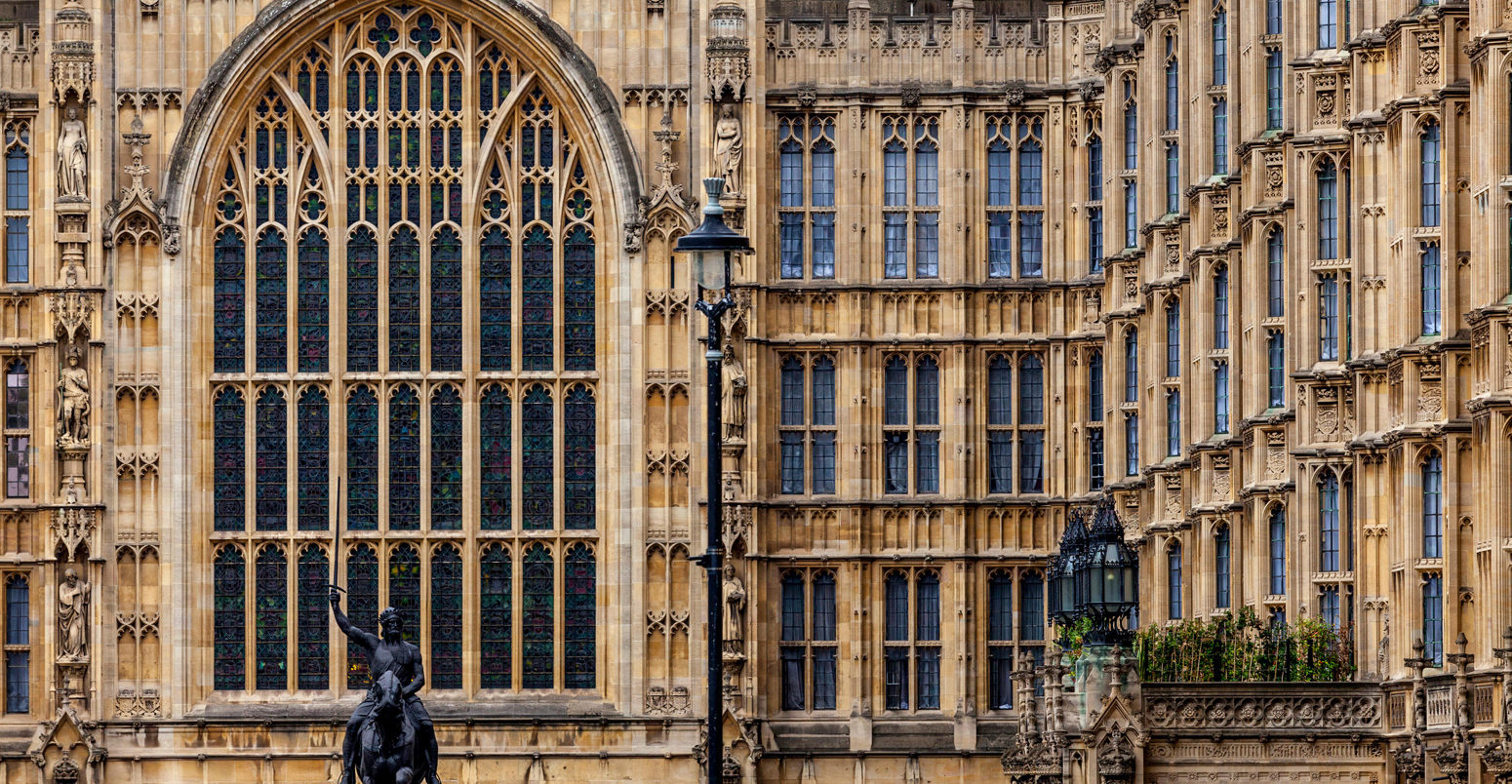
CCC: A plan to fill the UK’s climate policy gap is ‘urgently’ needed
Jocelyn Timperley
06.29.17Jocelyn Timperley
29.06.2017 | 12:01amThe UK government must “urgently” deliver plans showing how it intends to both tackle and prepare for climate change.
This is the key message within the latest annual progress report published today by the Committee on Climate Change (CCC), the government’s official climate advisers.
The government is statutorily obliged under the Climate Change Act 2008 to set out before Parliament how it will meet legally binding climate targets, which it is currently on track to miss.
The CCC stresses in its new report that policies should include how the government intends to reduce emissions in the crucial areas of transport and buildings, where emissions are currently rising.
The CCC also says the government should strengthen the UK’s National Adaptation Programme (NAP), including increasing the resilience of infrastructure to severe weather and tackling risks from surface water flooding.
Carbon Brief explains the key recommendations from the committee.
Policy delay
The UK’s Climate Change Act requires emissions to be reduced 80% by 2050 compared to 1990 levels. But it also says the emission reductions to meet this target should be broken down into five yearly “carbon budgets”, to be agreed upon with parliament.
The second carbon budget period ends this year and the government is thought to be on track to meet the third, which lasts from 2018 to 2022.
However, while the carbon reductions needed for the fourth and fifth carbon budgets, which together cover 2023 to 2032, have been set by parliament, current policy is not sufficient to set the UK on the right path to achieve these, as the CCC’s graph below shows.
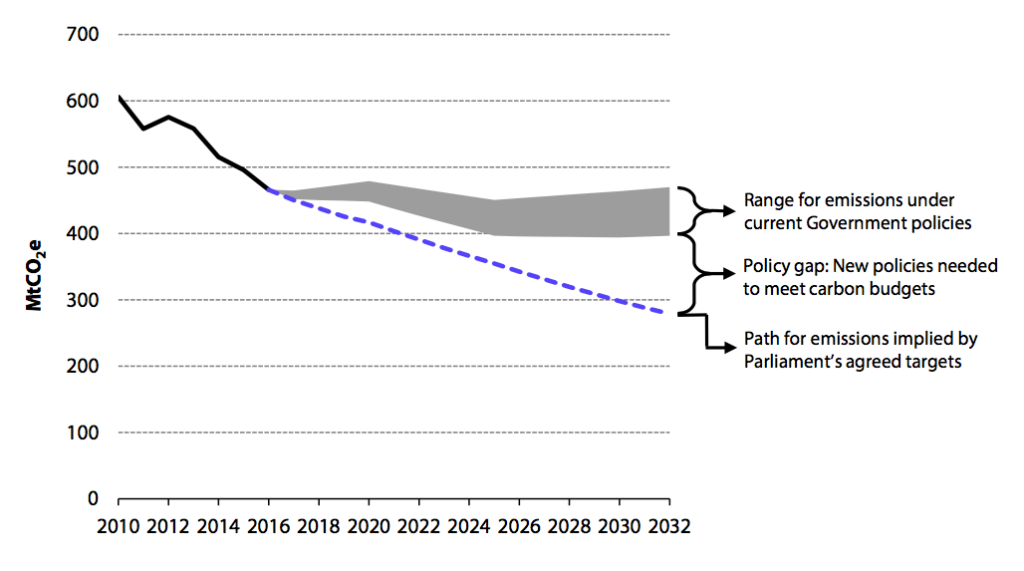
Current UK policies fall far short of what is needed to meet the targets agreed by Parliament]. Source: BEIS and CCC analysis. Chart by the CCC.
The Climate Change Act says the government should publish a plan to meet each carbon budget “as soon as reasonably practical” after it is passed. Matthew Bell, chief executive of the CCC, tells Carbon Brief this has historically been within about six months of the budget being passed, which would have meant the end of 2016 in this case.
After the fifth carbon budget was passed last year, the government began to talk about its “emissions reduction plan”, which morphed more recently into a “clean growth plan”. While this is understood to have been more or less ready to publish before Theresa May called the general election, new climate change minister Claire Perry this week confirmed to Parliament it will now be published after the summer recess which ends on 5 September.
However, speaking to journalists ahead of the launch of the new report, Lord Deben, chairman of the CCC, said he is confident the government will produce the plan since it is it is statutorily required. He said:
“The law is quite clear, and that is that once the parliament has passed a budget, it is then necessary for the government to publish its plan as to how it’s going to to meet that budget and it’s got to do so as rapidly as possible.
“Now, we have had an unprecedented series of activities over the past year. Given those circumstances it is still true that the government has got to meet its obligations. I think the government is fully aware of that. And when the government produces its report, it will then be our job to assess it and to say independently whether we believe that these are policies sufficient to reach what is now the statutory requirement.
Policy voids
Aside from awaiting confirmation about when the plan will be published, there is already much anticipation about what policies it will contain.
The UK has seen a significant drop in its greenhouse gas emissions over the past decade (domestic emissions are now around 42% lower than in 1990), though this has been largely due to decarbonisation of the power sector and improved energy efficiency.
The CCC notes that the government needs to set out how it will source a required extra 80 to 100 TWh of low-carbon electricity required for the 2020s.
But to meet the legally binding reduction targets – a 51% fall by 2025 and 57% drop by 2030 – new policies will be needed in other areas, too.
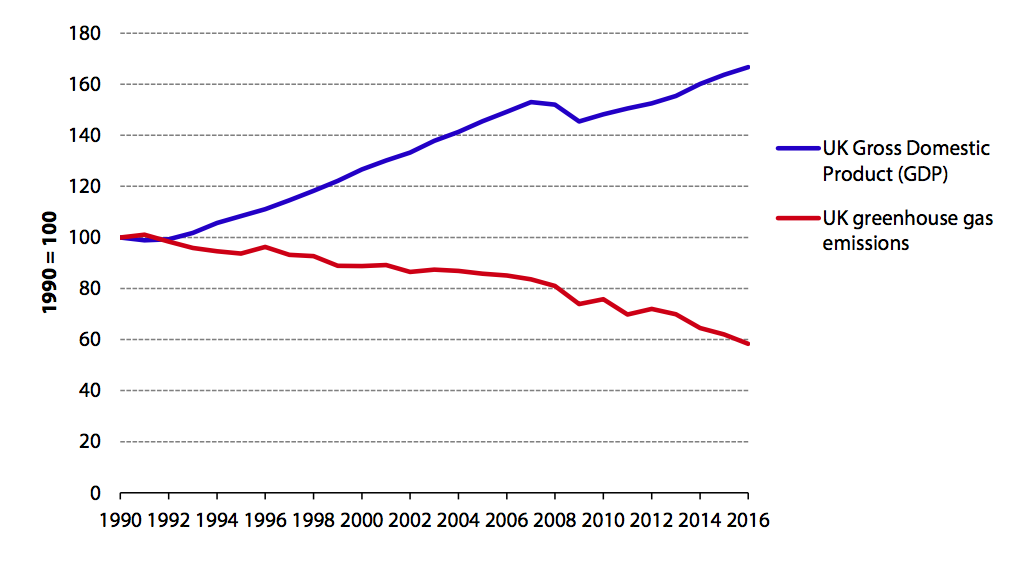
Emissions have fallen 42% while the economy has grown over 60% since 1990. Source: BEIS. Chart by the CCC.
Many of the UK’s domestic policies addressing climate change are set to expire around 2020. These include the levy control framework, which supports low-carbon power, and the renewable heat incentive to reduce emissions from buildings.
Meanwhile, Brexit will lead to the need to transfer much of the environment-related legislation from the European Union into UK law. Before the EU referendum last year around half of the emission reduction required to 2030 was expected to come from EU policies, which cover areas such as fuel efficiency standards for vehicles and the EU emissions trading system (EU ETS).
In addition, many of the programmes to increase the resilience of the natural environment to climate change are also driven by EU legislation, such as the Habitat and Birds Directive. These will need to be replaced by UK measures that are “at least as effective”, say the CCC.
Progress in many areas, such as buildings and transport, has been slow to date, with emissions in these sectors currently continuing to rise.
Meanwhile, the government’s abandonment of its carbon capture and storage (CCS) plans leaves industry without a long-term strategy for reducing emissions, the CCC says.
The five charts below show the policy gaps identified by the CCC in the fourth and fifth carbon budgets across key sectors. They show, for example, the extent of the policy gap for the transport sector. (Note that the y-axis is not the same across all the charts.)

The policy gap in the power sector. Source: CCC analysis based on BEIS (2017) Energy and Emissions Projections.
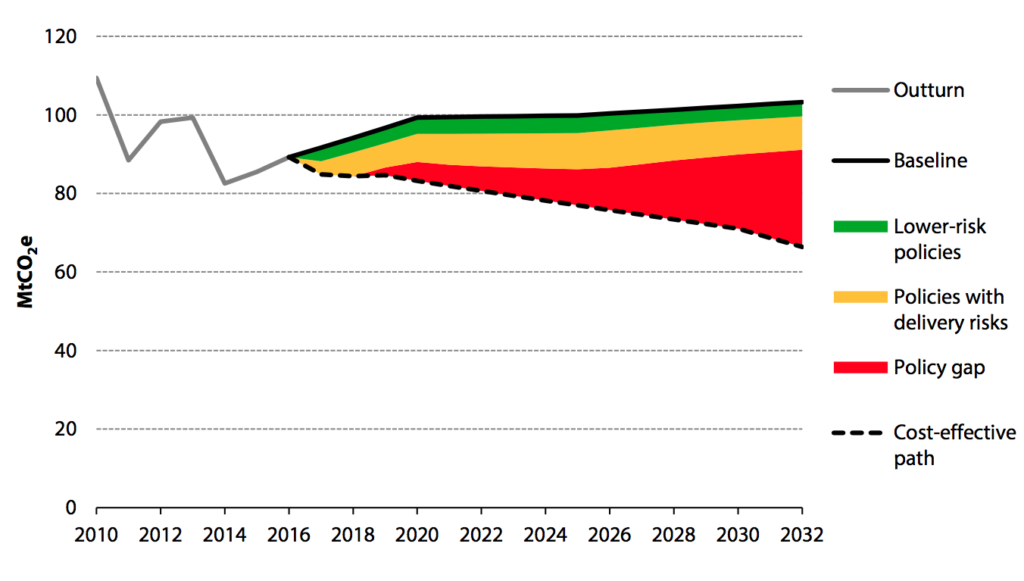
The policy gap in the building sector. Source: CCC analysis based on BEIS (2017) Energy and Emissions Projections.

The policy gap in industry. Source: CCC analysis based on BEIS (2017) Energy and Emissions Projections.

The policy gap in the transport sector. Source: CCC analysis
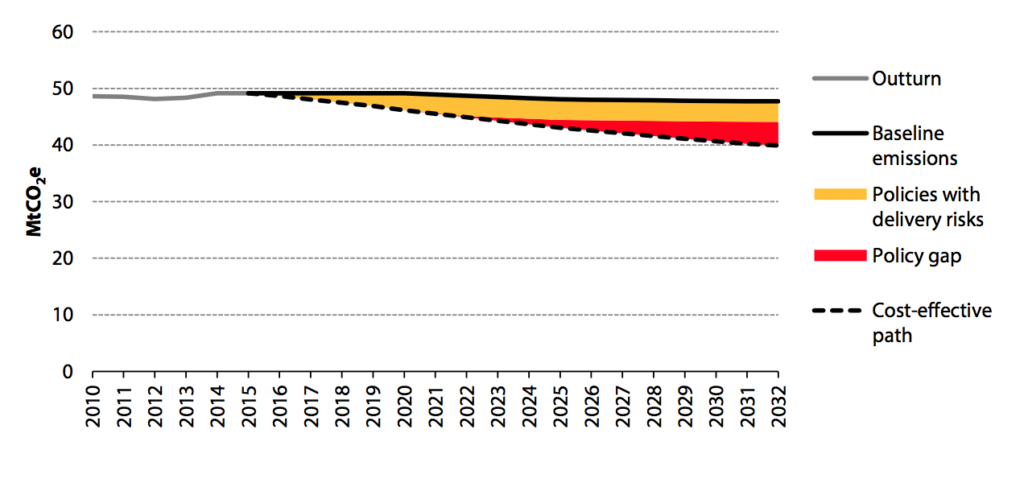
The policy gap in agriculture. Source: BEIS (2017) Final UK greenhouse gas emissions national statistics 1990-2015; BEIS (2017) Updated Energy and Emissions Projections 2016, and CCC calculations.
Responding to the CCC report, a government spokesman insisted that the UK continues to be a world leader in tackling climate change and is committed to meeting the UK’s targets set under the Climate Change Act 2008. He says:
“We have cut emissions by more than a third while growing the economy by over two thirds, and through our Industrial Strategy continue to support our burgeoning low-carbon sector which is helping deliver high-skilled jobs across the country.”
Transport and buildings
The CCC is clear that transport is a central area for new policy, both due to its impact on emissions and the associated problem of localised air pollution.
The CCC says the government will need to consider the ongoing technological “revolution”, such as autonomous vehicles and online shopping, and look at how the transition to electric vehicles can be sped up.
It will also needs to set stretching new targets for emissions from cars and vans after 2020, when current EU regulations are due to expire, and ensure aviation and shipping policy is consistent with carbon budgets, the CCC says.
Another key area of new policy needed from the government is a clear strategy for energy efficiency and low-carbon heat, say the CCC.
This will need to accelerate the delivery of energy efficiency measures, heat networks and heat pumps, and also test the possibility for low-carbon hydrogen to be used for heat.
Responding to a question from Carbon Brief on whether there could be any knee-jerk decisions on insulation as a consequence of the Grenfell Tower disaster, Bell says:
“The concern must be that in some way the installation of insulation [is] unsafe, and that’s something that clearly shouldn’t happen and resulted in the terrible tragedy at Grenfell. You should be able to install insulation measures in a safe way and appropriate way, that, at the end of the day, are about making sure that people, houses, and buildings are comfortable and affordable to live in.”
Meanwhile, measures to prevent overheating will also increasingly become important in the UK.
Professor Julia King, chair of the CCC’s adaptation sub-committee, says it will be important to bring more of the natural environment into towns and cities and consider how buildings can be designed to help increase resilience to a warming climate. She says:
“Clearly, it’s absolutely critical that everybody doesn’t resort to air conditioning to cool their buildings, because we want to decarbonising our electricity system. We don’t want to be increasing demand and we don’t want to be increasing the urban heat-island effect, which, of course, air conditioning does.”
Agriculture
Emissions from the agricultural sector tend to take a backseat, since they are viewed as challenging.
While the CCC’s scenarios show emissions falling by about 19% from now to 2030, the UK’s emissions have basically been flat since 2009, says Daniel Johns, the CCC’s head of adaptation. But the CCC says agricultural emissions will likely to be an increasing focus of its future reports.
The CCC says it expects the government’s forthcoming emissions reduction plan to address key aspects of agricultural emissions, with a focus on initial measures that improve farm efficiency, such as using fertiliser more effectively and increasing productivity of farms.
Bell tells Carbon Brief:
“We know that, post the fifth carbon budget, agriculture will have to start contributing in a much more significant way. That means we need to start laying the ground, preparing now, when it comes to looking at different measures that agriculture could take, whether it’s how we feed animals, or how we produce the crops that we currently produce. And some of that’s research and development, some of that’s trials and things that need to start happening through the 2020s.”
It’s also worth noting that agriculture is one of the areas where the CCC identifies opportunities to improve on current EU legislation, such as the UK’s reform of the Common Agricultural Policy (CAP).
1.5C omission
While the UK’s “80% by 2050” emissions reduction target was based on a global goal of limiting warming to no more than 2C this century, the 2015 Paris Agreement commits the world to aspire to limiting temperature rise to no more than 1.5C.
However, the CCC said last year there was no need yet for the government to tighten up its targets, although it did say this may be needed in the future.
While the CCC has still held back from recommending an increase in the UK’s emissions target, it continues to point out that the government’s proposals should leave open the possibility of reducing emissions more quickly than required by the current budgets. Bell says the CCC is “very clear” the Paris Agreement is more ambitious than the data upon which the UK 2050 target was set. He tells Carbon Brief:
“That means that, if anything, the carbon plan, which is now due out in the next session of parliament, should be at the top end of ambition. And we should be aiming, if anything, to over-delivering against the carbon budgets rather than just aiming to scrape by into just about meeting them.”
National Adaptation Plan
The government’s second UK “Climate Change Risk Assessment”, which looks at the country’s resilience to climate change impacts, was laid before Parliament by government in January 2017.
The assessment was underpinned by a 2,000-page report the year before from the CCC which urged the UK to address a number of urgent risks it faces due to climate change, from flooding and heat waves though to food insecurity and pests.
The government is required to lay out its plan for how to address those risks “as soon as is reasonably practical”. In the new report, the CCC calls for this National Adaptation Programme to be published in early 2018.
The following table from the CCC’s new report sets out the current adaptation priorities for the UK, including an assessment of whether there is a plan in place and if progress is being made. For comparison, Carbon Brief also covered the last report by the CCC’s adaptation sub-committee back in 2015, where it published a similar table.
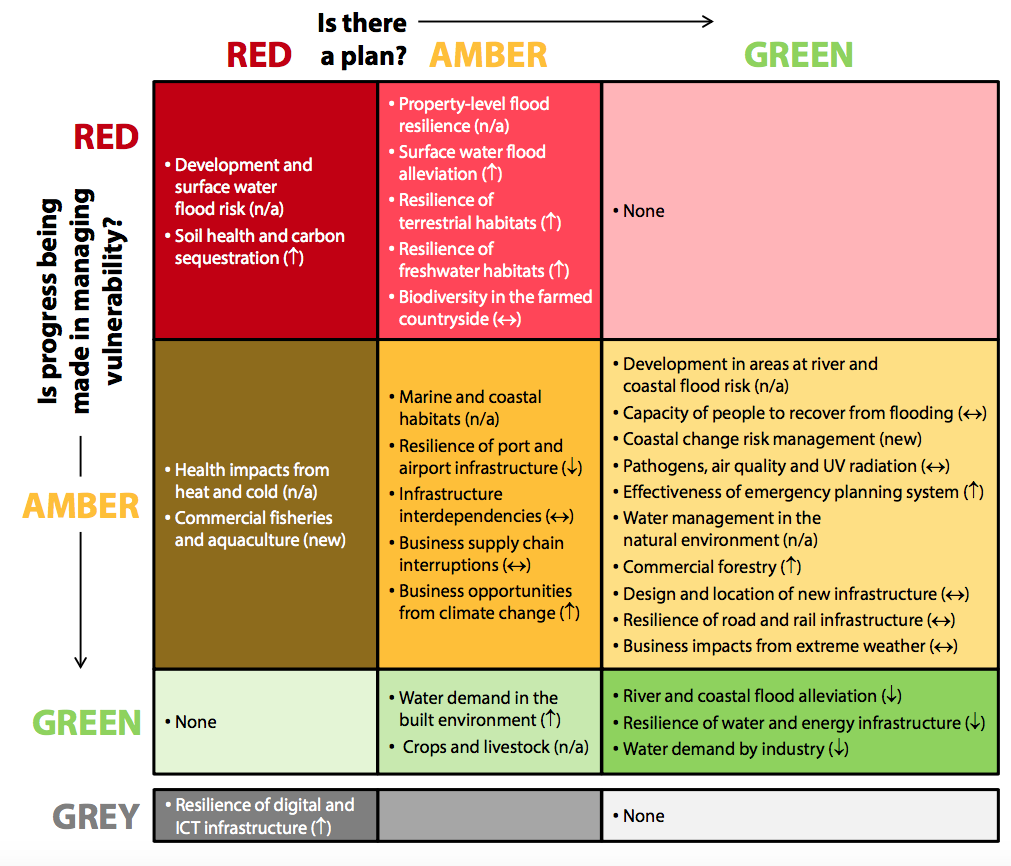
Matrix of adaptation priorities from the NAP. Shading of grid squares shows: plans and progress do not address climate change risks, indicators of vulnerability increasing; (red); plans and policies partially address climate change, indicators show mixed progress (amber); plans and policies are in place and indicators of vulnerability are falling (green). Changes to the assessment since 2015 are shown in brackets after the title: ↑ – increased concern, ↓ – decreased concern, ↔ – no change since 2015. Source: The CCC.
Current policies that govern the natural environment are due to expire in 2020, with many of the targets that the government set itself in that strategy on track to be missed.
For instance, only 25% of terrestrial protected habitats are in “good condition”, compared to the target of 50% by 2020. Continuing declines are also being seen in farmland, pollinated species, woodland butterflies, wetland, woodland and farmland birds, while the government is off-track against its own target for accrediting new woodlands. Jones says:
“It’s increasingly clear that all of the targets in that strategy won’t be met. So there is a lot of action going on, but because certain aspects of the natural environment are deteriorating it means they become less resilient to change, to climate changes as the climate warms.”
Areas of priority in adaptation set out by the CCC include providing more capital funding for flood defences – particularly surface water flooding – and providing a clearly targeted biodiversity plan.
The government must also act on wider international risks that could affect the UK, such as international supply chains, and recognise the important interdependencies between climate change risks, the CCC says.
New policies on the resilience of the natural environment are also expected to be set out in the government’s upcoming 25-year environment plan.
Responding to the CCC’s report on adaptation, a government spokesman says:
“We’ve implemented the majority of recommendations from the first National Adaptation Programme report and are pleased the CCC recognises the progress that has been made, but we agree there is a need to do more. That’s why we intend to publish the Clean Growth Plan when Parliament sits again after summer recess.”
Media coverage
Much of the media coverage of the CCC’s report focusses on the committee’s warnings over the lack of policy to tackle hot buildings amid a growing number of heatwaves.
The Financial Times concentrates on the CCC’s warning that the UK is “locking in problems for future generations” by designing buildings that become too hot in soaring summer temperatures, with modern glass buildings turning into greenhouses. A failure to update regulations could triple heatwave deaths by 2040, the CCC says.
“More than 90% of our population live in urban areas and as we have all been experiencing, heat is a significant problem,” says Baroness Brown, “Yet building regulations don’t cover heat and the management of high temperatures.”
Bloomberg also reports the CCC’s warnings on heat waves, quoting Lord Deben’s advice that air conditioning, which uses a lot of electricity and pushes heat out onto the streets, should not be viewed as a solution to the problem of overheating. Instead, planners should demand designs that cool buildings naturally and look to replicate designs already seen in Mediterranean countries, such as Portugal. Cladding walls in ivy and other climbing plants is another solution preferred by the CCC. Ivy-covered walls which can be 6C cooler than bare walls, says Baroness Brown.
The Daily Telegraph reports on the CCC’s call for a new target that electric vehicles should make up at least 60% of new cars and vans sold in the UK by the end of the 2020s. The committee suggests that the drive towards this electric vehicle boom should include tax incentives, financial support, a strategy to roll out electric vehicle charging infrastructure, as well as tougher emissions standards on new car sales beyond 2020.
The report also concludes that household energy bills and carbon emissions will rise unless ministers devise new policies to save power, according to the BBC. The Times and the Guardian also cover the CCC’s report.
Falling behind
With the government’s emission reduction plan still not published, the CCC report largely simply repeats its previous recommendations to fill policy voids around buildings, transport, CCS, the 2020s low-carbon electricity gap, and adaptation.
Lord Deben remains adamant on the need to plug these gaps. He says:
“This is a major issue which needs all the time to be kept in the public domain. That’s why we’ve got a Climate Change Act, why we’ve got a Climate Change Committee: it is to ensure that we don’t fall behind.”
If we fall behind, he adds, two big things will happen. First, dealing with climate change will become more difficult and expensive. Second, now that the vast majority of nations have signed up to the Paris Agreement, the UK has “a real need to keep ahead of the programme” due to its rising business interests in being able to help other countries meet their own requirements.

